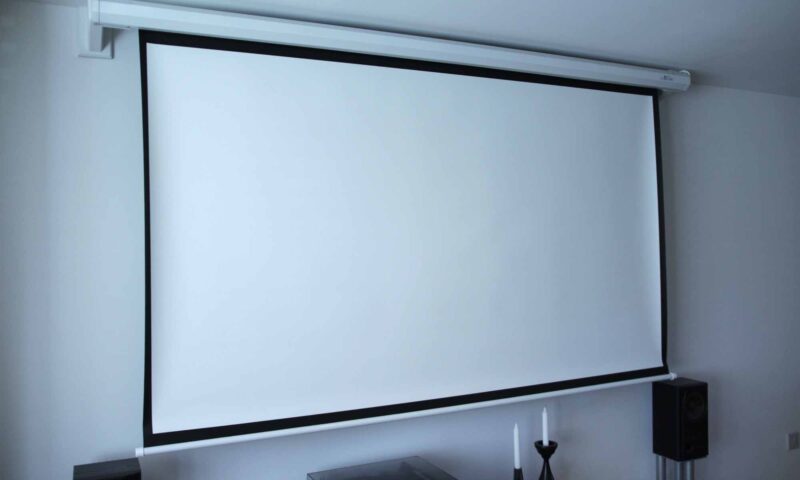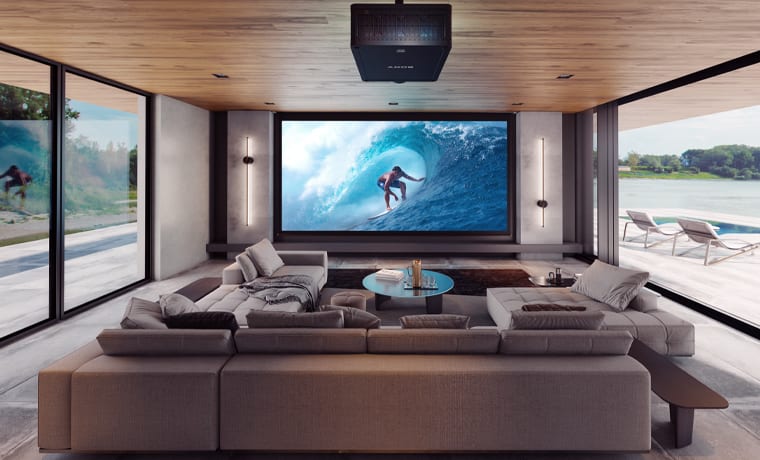A television is good, but a projector screen is better. With a projector, you get a wider view, making watching movies, playing games, and streaming TV shows more enjoyable. If you will set up one, we recommend a hidden projector screen.
You’ll keep the screen concealed in a compartment when not in use. When it’s time to watch, you activate the motorized mechanism to lift or drop the projector, depending on the design. You can place your hidden projector screen in several places at home. We’ll discuss that subsequently. Let’s first learn why such a setup is an advantage.
Working Mechanism of Hidden Projector Screen

The core of the hidden projector display is the motion mechanism that takes it in and out of its hidden compartment. We recommend linear actuators for that. These devices are popular for many home automation projects. So, applying one when setting up a hidden projector screen is just one of the many ways you can leverage them.
Deciding on the best actuator
No doubt, a linear actuator will make operating your hidden project screen more seamless. However, if you don’t employ the right one, it becomes a struggle. As a result, you must take care to purchase the best device. The factors that require particular attention include:
- Your projector screen’s waist. Here you’re considering the carrying capacity of the linear motion device.
- Travel range. Here you’re considering how far the actuator needs to lift or lower the projector display. It relates to the size or length of the compartment you use.
- Actuator speed. How fast or slow should the projector screen slide out of its hidden compartment? That’s what you’re deciding here. It’s not overly critical but still ideal to check for.
How to Install a Hidden Projector Screen

The first thing is to decide where to place the hidden screen. Then, attach the linear actuator mounting brackets with screws. Also, mount the screen using its brackets and hooks. Then, connect the actuator nut to the projector display. Finally, you connect the setup to a power source, and that’s all.
If the actuator uses a feedback receiver, then you’ll have a remote control or sensors. Otherwise, you connect the electric motor to a switch. While both are easy to operate, having a remote is far more convenient and stylish. Fortunately, many linear actuators support feedback.
Benefits of Hidden Projector Screen
Rather than consume, a hidden projector screen helps save space. You can install it in a compartment inside or behind other furniture around the house. The display will pop up or drop down using a motion mechanism, so it’s only in view when you want. It’s similar to a motorized TV lift that lets you hide your screen in a cabinet or wall.
Since the display stays out of sight unless, in use, it doesn’t affect your interior decor. If anything, a proper setup may add more beauty to your home outlook. For instance, you can install the hidden projector display behind a beautiful painting or well-crafted cabinet. Undoubtedly, this will add more grace to your room.
In terms of maintenance, it’s easy to see how a hidden projector screen facilitates things. The display stays safe from dust and dirt since it’s in a concealed compartment. That way, you get a device that will last long, ensuring visuals are always clear and sharp.
It’s worth mentioning that operating the hidden projector screen won’t be difficult. You won’t have to eject the display from its compartment manually. Instead, you press a remote button or a switch.
Best Location for a Hidden Projector Screen

From experience, the best place to hide your projector screen is inside a cabinet. You can see how it works with a linear actuator in the video on this page. Basically, you’ll set up the screen at the top of the furniture and drop down with the motion device. If you don’t have such a cabinet, it’s fine. There are still many other places you can hide your projector display.
You can place it on a wall, for example. For this application, the wall needs to have a slot or panel where the actuator will fit. Also, the screen will slide out horizontally. It’s perfect for a minimalist view.
Another workable option is in your ceiling. It’s similar to the cabinet option, as the display will drop down vertically. Like the wall example, your ceiling also needs a slot or panel to fit the setup.
Perhaps the simplest option is hiding the projector screen behind a painting. Here you can choose to slide the projector horizontally or vertically. However, you must take care during installation so the artwork doesn’t affect the actuator’s movement.
Acoustic Considerations
Creating a captivating home theater experience goes beyond just installing a hidden projector screen. To truly immerse yourself in cinematic magic, it’s crucial to consider acoustic factors and display size when setting up your hidden projector screen. These considerations play a pivotal role in achieving optimal audio performance and maintaining the integrity of the projected image.
Ensuring impeccable audio quality is a must when setting up your home theater. One potential pitfall lies in the choice of projector display material. Some can disrupt sound reflection and absorption, diminishing your audio experience. Luckily, the solution is straightforward – opt for acoustically transparent screens. They allow sound to seamlessly pass through, offering you crystal-clear and immersive audio for movies, games, and shows.
Display Size and Aspect Ratio

However, achieving the perfect viewing experience isn’t all about sound. Your screen’s size and aspect ratio play crucial roles too. Picking a display size that doesn’t align with your projector’s specs can lead to image cropping or distortion, ruining the immersive experience. It’s essential to match your display size and aspect ratio to your projector’s capabilities. Keep in mind your room’s dimensions, the distance from which you’ll view, and the type of content you favor – be it widescreen movies or gaming.
Conclusion
A hidden projector screen at home provides entertainment while protecting your investment. You get to save space and keep the display safe from harmful elements. It’s a versatile concept, as you can install it in various areas.
